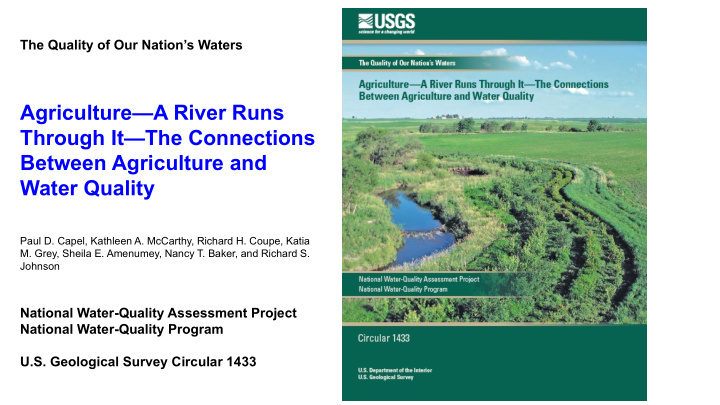



The Quality of Our Nation’s Waters Agriculture—A River Runs Through It—The Connections Between Agriculture and Water Quality Paul D. Capel, Kathleen A. McCarthy, Richard H. Coupe, Katia M. Grey, Sheila E. Amenumey, Nancy T. Baker, and Richard S. Johnson National Water-Quality Assessment Project National Water-Quality Program U.S. Geological Survey Circular 1433
Landscape modifications for agriculture have altered the natural flow of water and agricultural chemicals entering streams and aquifers An aerial photograph of an 11-square kilometer agricultural area in northcentral Iowa with many of its agricultural modifications identified. The cumulative effects of landscape modifications have led to adverse effects on the environment, including changes in water quantity, water quality, and the health of ecosystems.
Chemicals are used extensively in agriculture Considerable increases in fertilizer and pesticide use began in the 1960s. Increased levels of nutrients from fertilizers draining into streams can stimulate algal blooms and affect stream health and recreational uses of local streams, downstream reservoirs, and estuaries, and increase treatment costs for drinking water. Pesticides that are transported to streams can pose risks for aquatic life and fish-eating wildlife and drinking-water supplies.
Tracking how water moves through agricultural landscapes provides insights on the movement of agricultural chemicals Most historical and current water-quantity and water-quality impacts from agriculture are the result of the modification of the natural water flowpaths and (or) the use of chemicals.
Water flowpaths determine how and how quickly chemicals are transported from fields to streams Water flowpaths on agricultural lands. Areas in crop agriculture that are expected to have slowflow, fastflow, and drainflow as their important flowpaths, as well as areas that have a mixture of flowpaths.
Nitrogen and phosphorus, used in fertilizers, are transformed into different chemical forms as they move through the environment, but they do not disappear Accounting for the annual inputs and outputs of nitrogen in agricultural watersheds provides insights on the “excess” component, which is the amount of nitrogen that moves into the groundwater and streams and contributes to water-quality concerns.
Agricultural activities impact water quality at many scales A large hypoxic area develops in the Gulf of Mexico each summer. When oxygen levels are less than 2 milligrams per liter, less mobile or immobile animals such as mussels, cannot move out of the hypoxic areas and often are killed during widespread hypoxic events. Nutrients from sources, such as farm fertilizers, animal manure, and urban areas contribute nutrients that stimulate the growth of algae that die off and deplete oxygen levels in the Gulf of Mexico (top). Areas contributing the largest amounts of nitrogen to the Gulf of Mexico are located in the corn and soybean growing region from Kansas to Ohio (bottom left). The relative importance of various watershed sources of nitrogen to the Gulf of Mexico. Agricultural activities contribute 60 percent of the total nitrogen.
Pesticides and their transformation products are detected throughout the environment Although less than 1 percent of the herbicide metolachlor that is applied each year moves off the field into streams and groundwater, metolachlor is found in all hydrologic components in many agricultural areas where it is applied. The values are the typical percentage of the annual application of metolachlor. However, not enough is known about the transformation products to the same type of mass budget.
Some parts of the landscape disproportionately affect water quality The concentration of nitrate in groundwater is not evenly distributed across the Chesapeake Bay watershed due to differences in land uses, nitrogen use as fertilizer, and type of underlying aquifer.
Strategic, long-term water-quality monitoring and modeling provide a basis for sound management decisions The Maumee River flows through the intensely row-cropped area of northwestern Ohio into Lake Erie. The trend in nitrate concentration in the Maumee River showed a rapid increase between 1950 and 1980 as nitrogen inputs from fertilizer and livestock increased. This record of nitrate river concentrations and fertilizer use for almost six decades provides a perspective that short-term monitoring efforts may miss.
Understanding the connections among hydrologic settings and chemical behaviors can help set realistic expectations for water-quality improvements A Simple Decision Tree Connects Water Flowpaths, Chemical Behavior, and the Effectiveness of Agricultural Activities The decision tree can assist with identification of which agricultural activity(s) could be effective in protecting or improving stream-water quality and which agricultural activity(s) could be counterproductive. * denotes that these chemicals do not usually cause a water- quality concern from the part of the water moving through subsurface, but they can cause a concern in the part of water moving through flowpaths across the land surface.
The Challenging Connections Between Agriculture and Water Quality We are entering a time of unprecedented demands upon the Earth and its resources. Some 7 billion humans inhabit this single planet, all of whom need food to eat, fiber for clothing, shelter for protection from the elements, and clean water to drink. The challenges for agriculture are great and the stakes are high. Can agriculture on a global basis produce enough food, fiber, and fuel to satisfy the needs of humanity, and do it in such a way that it is ecologically sustainable, so as not to degrade the quality of our air, water, soil, and other natural ecosystems? This, then, is the challenge. Meeting the goal of providing for the material needs of humanity will require a cooperative effort among producers, scientists, consumers, and policy makers to think seriously, plan carefully, and develop a sound strategy to wisely use the Earth’s resources.
Recommend
More recommend